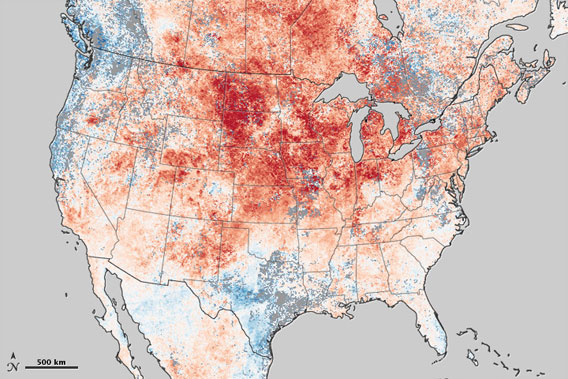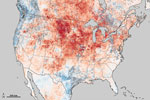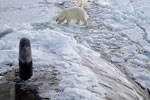
NASA map shows temperature anomalies from March 13-19, 2012 as compared to the same eight day period during the past 12 years based on data captured by the Moderate Resolution Imaging Spectroradiometer (MODIS) instrument on NASA’s Terra satellite. Click to enlarge.
As North America recovers from what noted meteorologist Jeff Masters has called “the most incredible spring heatwave in U.S. and Canadian recorded history,” a new paper argues that climate change is playing an important role in a world that appears increasingly pummeled by extreme weather. Published in Nature Climate Change, the paper surveys recent studies of climate change and extreme weather and finds “strong evidence” of a link between a warming world and the frequency and intensity of droughts, floods, and heatwaves—such as the one that turned winter into summer in the U.S.
“The question is whether these weather extremes are coincidental or a result of climate change,” says lead author, Dim Coumou, with the Potsdam Institute for Climate Impact Research (PIK), in a press release. “Global warming can generally not be proven to cause individual extreme events—but in the sum of events the link to climate change becomes clear. It is not a question of yes or no, but a question of probabilities.”
Coumou and other climatologists have begun to refer to this extreme climate phenomenon as playing with “loaded dice.” In other words, prior to climate change, extreme weather events occurred within historical statistical norms, but now they are occurring more frequently as climate change has “fixed” the weather-die to land more often on extreme.
Coumou explains, “A six can appear every now and then, and you never know when it happens. But now it appears much more often, because we have changed the dice.”
As to the recent spring heatwave in the U.S., in which over a thousand temperature records were broken, the researchers write in a follow-up blog that “the probability for ‘outlandish’ heat records increases greatly due to global warming. But the more outlandish a record is, the more would we suspect that non-linear feedbacks are at play—which could increase their likelihood even more.” Non-linear feedbacks are inputs that are not directly proportional to average rises in temperatures, in other words just because the climate has risen on average by around 0.8 degrees Celsius (1.44 degrees Fahrenheit) doesn’t mean other feedbacks won’t push record temperatures far above that.
Coumou and co-author, Stefan Rahmstorf also with PIK, point to three types evidence linking climate change to extreme weather events: physics, statistics, and computer modeling.
The physics of climate change predicts, not surprisingly, that heat records will be broken more often than cold records. In addition, because warm air causes more evaporation than cold, drought is also expected to increase in places. Conversely, climate change will increase the likelihood of flooding and mega-snowstorms, because warmer air holds more moisture.
Statistical analysis hints at a rise in record events, for example the paper notes that “the past decade as a whole has seen an exceptional number of unprecedented extreme weather events, some causing major human suffering and economic damage.” Meanwhile computer modeling allows researchers to look at complex interactions within the climate system and tease out the probability of extreme weather events under climate change.
Notable (and destructive) extremes
The last few years has seen a number of destructive and deadly extreme weather events, many of them record-breakers, some of them shatterers.
In 2003 Europe suffered the worst heatwave in at least 500 years, according to the paper. Tens of thousands of people perished in the heatwave. Seven years later, Russia had its warmest summer on record. The droughts and fires that followed decimated a third of Russia’s wheat crop, leading the country to put a moratorium on wheat exports. A massive drought in Texas last year, the worst one-year drought since record keeping began in 1895, led to livestock and crop losses of nearly $8 billion, massive wildfires, and water shortages. The drought with the highest human cost, however, was in East Africa last year. Failed rains, which produced the worst drought in at least 60 years in the region, lead to famine in Somalia where some 50,000 to 100,000 people perished, half of whom were likely children under five. While the famine was worsened by lack of governance and terror groups, the drought was the ultimate cause.
“Recent years have seen an exceptionally large number of record-breaking and destructive heatwaves in many parts of the world. Several recent studies indicate that many, possibly most, of these heatwaves would not have occurred without global warming,” the climatologists write.
Of these, the U.S. spring heatwave may be the most benign of the bunch, however it will likely have impacts on soil moisture, wildlife migrations, and agriculture, especially in places where it has been followed by a hard frost. Worst though, if the unusually warm spring is also connected to the surprising number of early tornados this year then climate change may also be implicated, at least in part, in the damages and fatalities that have occurred from 200 plus tornadoes across Central U.S.
But it’s not just unprecedented heatwaves that have occurred over the past decade. Last year, Thailand experienced its worst flooding on record with total damages exceeding $45 billion according to the World Bank. During the same year, South Korea experienced its wettest summer yet with floods killing 69 people in Seoul. Going backwards, in 2010, Pakistan experienced record rainfall and its worst flood disaster, impacting some 20 million people and killing around 3,000. Three years earlier England and Wales saw its wettest summer on record going all the way back to 1766, the resulting damage cost billions of dollars.
The study notes that researchers are still unclear as to how climate change will impact hurricane frequency and intensity, but that “anthropogenic, unprecedented heat and rainfall extremes are here—and are causing intense human suffering.”
CITATION: Dim Coumou and Stefan Rahmstorf. A decade of weather extremes. Nature Climate Change. 2012.
Related articles
NASA image: records shattered across U.S. as summer arrives before spring

(03/22/2012) Central U.S. and parts of Canada have seen over a thousand record temperatures shattered over the past week and a half, as an abnormally-long and bizarrely-hot warm spell moves across portions of North America. The direct cause of the weird weather is a blocked high pressure system, but as the U.S. experiences what may be the warmest March on record, meteorologists say climate change may be playing a role in the severity of the heatwave.
2010, not 1998, warmest year on record
(03/20/2012) An updated temperature analysis by the Met Office and the University of East Anglia’s Climatic Research Unit has confirmed that 2010, not 1998, was the warmest year since record keeping began in the late 19th Century. The new analysis adds in temperature data from 400 stations across northern Canada, Russia, and the Arctic, which had been left out of the previous analysis.
Climate change could increase fires, logging, and hunting in rainforests

(03/13/2012) The combined impacts of deforestation and climate change will bring a host of new troubles for the world’s tropical rainforests argues a new study in Trends in Ecology and Evolution. Drying rainforests due to climate change could lead to previously inaccessible forests falling to loggers, burning in unprecedented fires, or being overexploited by hunters.
Tornado season likely to expand due to climate change
(03/06/2012) Last Friday, around a hundred tornadoes left a wake of destruction in the U.S., killing 39 people to date and destroying entire towns. The tragedy hit hardest in Kentucky and Indiana and experts predict the weather-disaster will cost over $1 billion. But isn’t this early for tornado season? Yes, say experts, and climatologists add that while research on tornadoes and climate change is currently in its infancy, it’s possible, probably even likely, that climate change is expanding tornado season in the U.S. due to the earlier arrival of spring.
Arctic warms to highest level yet as researchers fear tipping points

(02/13/2012) Last year the Arctic, which is warming faster than anywhere else on Earth due to global climate change, experienced its warmest twelve months yet. According to recent data by NASA, average Arctic temperatures in 2011 were 2.28 degrees Celsius (4.1 degrees Fahrenheit) above those recorded from 1951-1980. As the Arctic warms, imperiling its biodiversity and indigenous people, researchers are increasingly concerned that the region will hit climatic tipping points that could severely impact the rest of the world. A recent commentary in Nature Climate Change highlighted a number of tipping points that keep scientists awake at night.
Featured video: NASA releases shocking 30 second film on climate
(01/30/2012) NASA has created a new animation showing global temperatures on a map of the Earth from 1880-2011. On the map, blues represent temperatures lower than baseline averages, while reds indicate temperatures higher than the average. As the 131 years pass, the map turns from bluish-white to increasingly yellow and red. Caused by the burning of fossil fuels, deforestation, agricultural practices, and other human impacts, climate change has currently raised temperatures 0.8 degrees Celsius (1.44 degrees Fahrenheit) higher than the Industrial Revolution average.